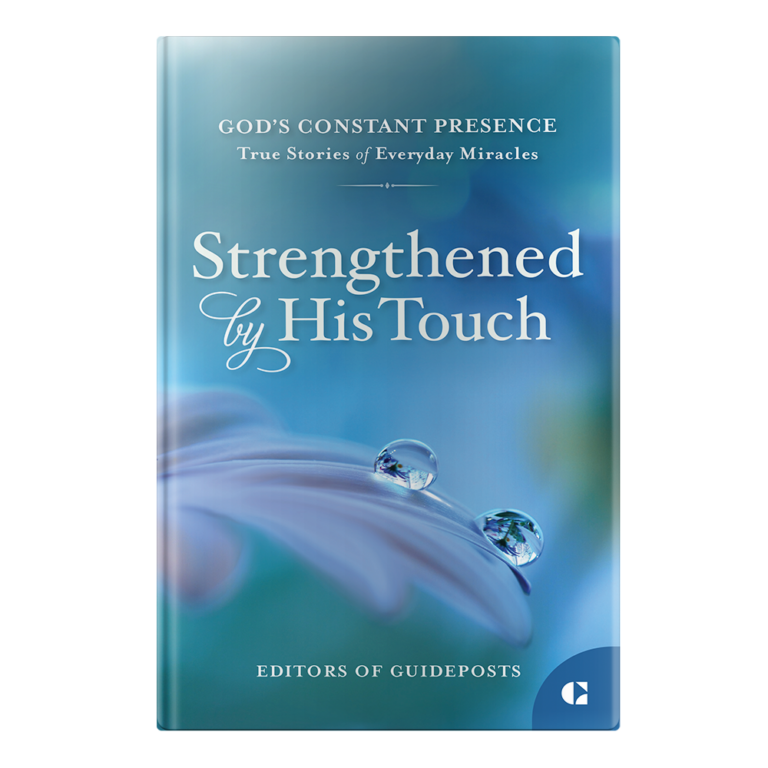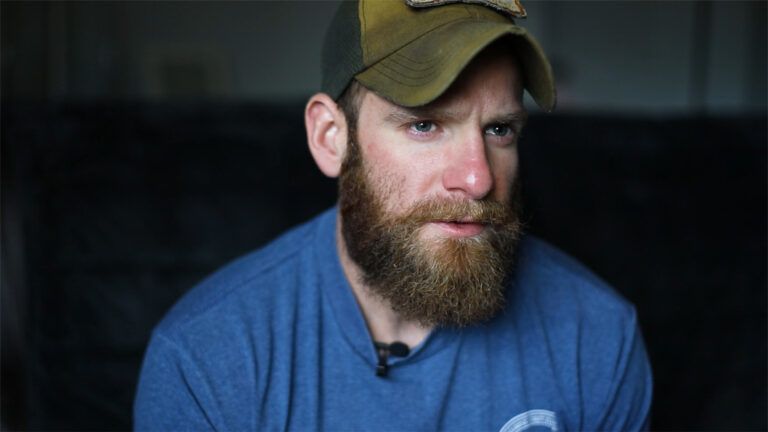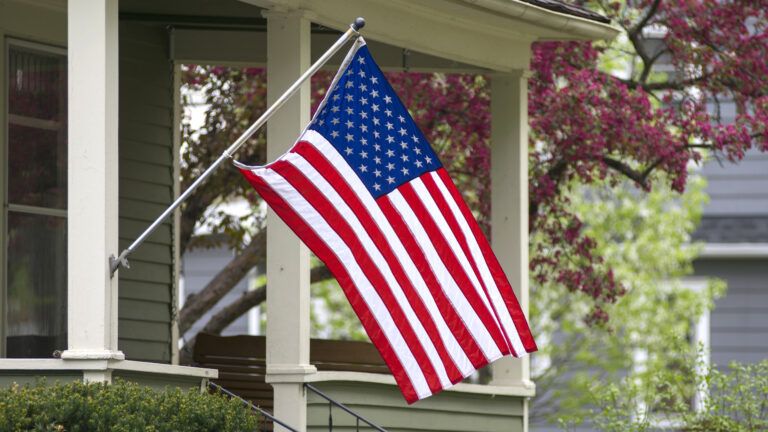Ambush! A hailstorm of bullets hemmed us in. We were trapped on a narrow road northeast of Baghdad that March day in 2007.
Atop our Stryker, a huge armored military vehicle, I manned a machine gun, searching for targets while providing cover so the guys on the ground could get to the wounded. Through the headset in my helmet, connected to a communication cord, I listened for orders.
Below me a soldier waved urgently, an injured man on the ground beside him. “Open the ramp,” he yelled. “We’ve got to get him inside.”
Bring faith and inspiration to our troops! To donate a Guideposts subscription now, click here.
I dropped into the Stryker and lowered the ramp. As I ran for the injured soldier, my head was jerked backward and my legs flew out from under me. The comm cord. I’d forgotten to unplug it. My neck hit the bottom of the ramp. I gasped. The soldier. I had to get him.
I threw off my helmet, staggered to my feet. Wrapped my arms around the soldier, a man twice my size, and dragged him inch by agonizing inch into the Stryker. Blood streamed from his neck.
I shoved my fingers into the wound and, praying desperately that he wouldn’t bleed out, yelled for a medic. No one came. The guys around me were yelling too. It seemed like forever before one arrived.
“Are you a medic?” he asked me.
“No. Just a combat photographer.”
He stared. I’d gotten used to that. No one expected to see a photographer, especially a woman, on the front lines. It wasn’t as if I’d dreamed about it either, growing up in South Dakota, even though I always knew I wanted to serve my country.
I came from a military family. My great-grandfather was a Marine in World War I. My grandfather was in World War II. My dad served in the Navy, and my older sister was in the Air Force.
I’d enlisted right out of high school. I’d loved my art classes and figured I’d become an illustrator, creating posters and doing web design for the Air Force.
But after basic training I found out there were no available slots for artists. I settled for what seemed like the next best thing: photography. I didn’t know much about cameras, but I thought it would be creative. Not exactly. I spent my first four years developing film captured by U-2 spy planes.
Finally, in 2001, a combat-photography slot opened—a position that almost never did. We had troops on the ground in Afghanistan. Photographers had to be able to shoot a camera and a gun almost interchangeably, while carrying 80 pounds of gear and equipment.
The other soldiers had to trust that you knew how to respond under fire, at a time when women were banned from official combat roles.
I begged to be recommended. Still, I was as shocked as anyone when I got the job. I spent many months in training before I was sent to Iraq.
I’d noticed how the other, more experienced, photographers concentrated on action shots, the heat of battle. I decided to focus on quieter moments, showing the day-to-day life of a soldier.
Our photos were published in newspapers and on military websites. Generals, the Joint Chiefs, even the President, reviewed our work. Thousands of miles away, they saw the war, the troops, through our lenses, and sometimes made strategic decisions based on what they saw.
One night I photographed wounded soldiers being loaded onto a cargo plane. To avoid being spotted by insurgents, the flight was scheduled to take off before sunrise. I worked all night shooting pictures of the men being carried into the plane, the medics and doctors caring for them, comforting them.
Just before dawn the radio crackled. There’d been an IED blast. A soldier had been terribly wounded. Could we wait for one more man? The sun was peeking over the horizon. We’d be an easy target if we stayed here much longer.
The pilot asked the passengers what they wanted to do. The decision was unanimous.
An hour later, the medevac helicopter landed. I hustled to capture the scene of the medics transporting this one man they’d all waited for. I couldn’t help but be moved by our soldiers’ sacrifice, their courage and commitment.
It was an honor to photograph them, to be able to share this moment with the world. I was 23. For the first time I felt like I’d found my purpose in life. I was where God wanted me to be, doing what he’d called me to do, serving him and my country.
That year I was recognized as the Military Photographer of the Year by the National Press Photographers Association, an award only one other woman had ever won.
Still, it wasn’t easy to fit in. I thought I had to be tougher, more determined, than the men. In 2004 I survived an IED blast. I didn’t tell anyone how badly my neck and head hurt. None of the guys who were with me were complaining. I just popped some Motrin and went back out on assignment.
One day a soldier told me, “Pearsall, I don’t think of you as a girl.” That was the best compliment I could receive.
I worked through the pain. Injuries were part of the job, and I couldn’t imagine doing anything else. It was no surprise that I fell in love with and married another combat photographer, Andy Dunaway, someone as passionate about the work as I was.
That passion, I thought, would carry me through even the roughest moments. Like that ambush northeast of Baghdad in 2007, dragging the soldier to safety amid a crossfire of bullets. My neck had struck the ramp right where I’d injured it three years earlier. The pain was searing.
Again I didn’t tell anyone. I thought admitting my pain would be a sign of weakness.
Back at the base I got tremors in my hands. It was all I could do to pick up a camera. I couldn’t hold my head straight without pain radiating through my body. Just getting out of my bunk was agonizing. One day I couldn’t even do that. “I’m taking you to the doctor,” a buddy said.
The doctor took some X-rays. “Why haven’t you come here before now?” he said, his face grim, almost angry. “Your neck vertebrae are fused together. One more hard fall or blast could sever your spinal cord. You could be paralyzed. You need a CAT scan. Now.”
A helicopter took me to the military hospital in Balad. Given the nature of my injuries, they couldn’t be treated in theater. Soon I was on a plane home to Charleston Air Force Base in South Carolina. Andy wasn’t released to be with me. He couldn’t be spared.
Three different doctors told me I needed surgery. But recovery would take months, and I couldn’t be laid up for that long. I chose a less invasive treatment called prolotherapy, a series of injections that stimulate growth and repair in connective tissue.
“This will be a long and painful process,” the doctor warned. “And it won’t work if you’re on painkillers or antiinflammatory drugs.” I was still on active duty, but work restricted. If it meant getting back to my unit sooner, I figured, I could handle not taking painkillers.
Wrong. Now there was no relief. I had excruciating headaches. My neck throbbed constantly. It felt like hot needles were stabbing my back and arms.
Andy called often. “You’re going to get through this,” he told me until I was tired of hearing it.
“It’s hard without you here,” I said. “I can’t begin to explain what the pain is like. I don’t know how much more I can take.”
The smallest task, like heating up a can of soup, was an ordeal. The hardest part was finding the strength—mental as much as physical—just to get out of bed. There were days I couldn’t do it. I’d never felt so alone. Even God seemed unreachable, my prayers as weak as I was.
It didn’t help when I was awarded the Bronze Star Medal. I asked for a private ceremony. I didn’t want my peers to know or to ask me questions. I wasn’t ready to talk about it.
Later, word came that I again would be recognized as Military Photographer of the Year. An honor—and a stinging reminder that I hadn’t been able to pick up a camera in months. What if I was never able to? Being a photographer was my calling. What would I have to live for?
One day, driving home from yet another doctor’s appointment, I passed under a bridge. I pictured my foot pressing down on the gas. If I hit the concrete embankment head-on, the pain, the despair, would end. I let the car drift to the right and closed my eyes.
Click here to donate gift subscriptions to Guideposts Military Subscription Program.
I thought of Andy. How much he loved me. My eyes flew open. I gripped the steering wheel. I couldn’t do it. Couldn’t hurt my husband like that, my family. They’d been there for me. Prayed for me.
My life still felt hopeless. But that moment I knew I couldn’t give up. God had put me on this path. It wasn’t an accident that I was a combat photographer. Surely he wasn’t through with me.
I didn’t get better the way I’d hoped. The pain lessened to a point, but I continued to suffer debilitating headaches. After 18 months at home I still couldn’t exert myself. My military doctor recommended I be released from service.
In August 2008 I retired from the Air Force. Knowing that I no longer had a purpose, that I wasn’t needed—that was a whole different kind of pain. I couldn’t even go to the same doctor anymore. I had to go to the VA hospital like other retirees.
At my first appointment I sat in the waiting room, staring at my feet. The room was crowded with vets. All of them men. A lot older than me.
“Did you bring your grandfather in for an appointment?” a man asked.
I looked up. His face was creased and wrinkled, but there was a twinkle in his eye. Was he flirting with me? I had to smile. “No, sir, I’m a veteran.”
He did a double take. “Things sure have changed,” he muttered.
I should have been put off, but there was something about him that reminded me of my great-grandfather. “Sir, where did you serve?”
“I was in the Army. World War II,” he said, the bravado gone. “I was there when we liberated the concentration camps. That’s something that stays with you.”
I looked again at the lines carved in his face, imagining the life he’d lived. Like so many of his generation, he was a hero, fading into the background, mostly forgotten. We introduced ourselves. Then a nurse called him in.
“Thank you for your service,” I said.
“You too,” he replied. “Welcome home, honey.”
If only there was something more I could do for him. Had he ever had a professional portrait taken? A keepsake to pass on to his children and grandchildren? I kicked myself for not bringing my camera. All these years I’d never gone anywhere without it. Clearly I’d lost my edge.
I looked around the waiting room at the veterans, all of them hurting. Feeling alone, abandoned. I knew their pain. I was one of them.
And yet there was a strength to them. A dignity. They were still bound by a higher purpose. Like those medics and wounded soldiers I’d photographed on that cargo plane in Iraq. I had an idea.
A few days later, with the permission of the hospital, I set up a small studio at the end of a hallway. I was arranging the lights when a patient walked by.
“What are you doing?” he asked.
“I’m taking pictures of veterans,” I said. “You interested?”
“Sure. Nothing else to do.”
He sat down and for the first time in months I looked through the lens of my camera. He told me he had been a medic in Vietnam. His face was etched with worry, but when he looked into the camera I got goose bumps. This man was a warrior. Strong. Intense. Courageous.
I shot at least a dozen images. I could have photographed him all day. It felt like the answer to a prayer I hadn’t even said.
When we were finished I hugged him. “Thank you for your service,” I said. “I’ll get the best photo printed for you. I appreciate what you’ve done for our country. You’re not alone. I want you to know that.” That afternoon another veteran posed for me. The next day I photographed three more.
Word spread about what I was doing. The creative director at the hospital asked if it would be okay to hang the photos along the main hallway. By then I’d shot portraits of 150 veterans, men and women, including the World War II vet I’d met my first day at the VA.
I’d been doing this for them, and for me, not for the public. But I didn’t have to think twice about my answer. “I’d be honored,” I said.
That was the first of many honors I’ve received for what has become known as the Veterans Portrait Project. Last year I was recognized by the White House. It was good to know the President was still following my work. By then I’d photographed more than 3,000 veterans across the country.
Every week more requests come in. With the support of donors and sponsors, I travel to VA hospitals, VFW gatherings. The work isn’t easy. I’m still recovering from my injuries. I depend on assistants and I have to pace myself. I lean heavily on my faith. I couldn’t do it without Andy’s support.
But I feel renewed following my calling, using my God-given gift for photography to shine a light on my fellow veterans, whose commitment and sacrifices I want to make sure are never forgotten.
Click here to learn more about Veterans Awareness Month and what you can do to help.






